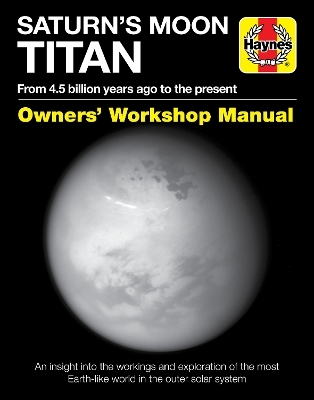
Saturn's Moon Titan
From 4.5 billion years ago to the present
Seiten
2020
J H Haynes & Co Ltd (Verlag)
978-1-78521-643-5 (ISBN)
J H Haynes & Co Ltd (Verlag)
978-1-78521-643-5 (ISBN)
A fascinating insight into a place within our own solar system where there are very similar conditions to those on ancient Earth, and where scientists are planning to send new and innovative exploratory probes, as they believe there is a possibility of discovering primitive forms of life, and of learning more about the development of early Earth.
Titan is a moon of Saturn, most recently explored by the Cassini/Huygens probes.
Titan is of huge interest to scientists, as the conditions in its atmosphere and on its surface bear a striking similarity to those of early Earth. It is thought that there is a realistic possibility that forms of primitive life could develop – or may already have developed – on the surface or in the oceans of Titan, and so there are plans to send further probes to Titan in order to further explore the conditions on its surface and in its oceans.
The theme of the book is how Titan works 'as a planet', with an emphasis on illustrating the features and processes of Titan with familiar analogues and imagery of geographical and geological features on Earth. The final chapter looks at Titan in practical terms as an environment for humans in the future, bringing the place 'to life', a little in science fiction style, but grounded in fact.
Titan is a moon of Saturn, most recently explored by the Cassini/Huygens probes.
Titan is of huge interest to scientists, as the conditions in its atmosphere and on its surface bear a striking similarity to those of early Earth. It is thought that there is a realistic possibility that forms of primitive life could develop – or may already have developed – on the surface or in the oceans of Titan, and so there are plans to send further probes to Titan in order to further explore the conditions on its surface and in its oceans.
The theme of the book is how Titan works 'as a planet', with an emphasis on illustrating the features and processes of Titan with familiar analogues and imagery of geographical and geological features on Earth. The final chapter looks at Titan in practical terms as an environment for humans in the future, bringing the place 'to life', a little in science fiction style, but grounded in fact.
Dr. Ralph Lorenz is a planetary scientist on the Principal Professional Staff of the Johns Hopkins University Applied Physics Laboratory (APL) in Laurel, MD, USA. He was a member of the Cassini Radar team, and helped to develop the Huygens Surface Science Package. He has played a major role in the definition of a range of US and European Titan mission concepts, from airships and hot-air balloons, through airplanes, landers and even a submarine. Thomson–Reuters Sciencewatch in 2011 named Ralph Lorenz as one of the world's top planetary scientists by impact. He is currently working on a design study adopted by NASA for a quadcopter probe named 'Dragonfly', designed to explore Titan.
| Erscheinungsdatum | 28.08.2020 |
|---|---|
| Reihe/Serie | Owners' Workshop Manual |
| Zusatzinfo | 275 Illustrations |
| Verlagsort | Somerset |
| Sprache | englisch |
| Maße | 210 x 270 mm |
| Gewicht | 830 g |
| Themenwelt | Sachbuch/Ratgeber ► Natur / Technik ► Weltraum / Astronomie |
| Naturwissenschaften ► Physik / Astronomie ► Astronomie / Astrophysik | |
| ISBN-10 | 1-78521-643-0 / 1785216430 |
| ISBN-13 | 978-1-78521-643-5 / 9781785216435 |
| Zustand | Neuware |
| Haben Sie eine Frage zum Produkt? |
Mehr entdecken
aus dem Bereich
aus dem Bereich
Perspektiven auf die Menschheit
Buch | Hardcover (2024)
Klett-Cotta (Verlag)
CHF 34,95
auf der Suche nach neuen Planeten und außerirdischem Leben
Buch | Hardcover (2024)
Droemer (Verlag)
CHF 33,55


